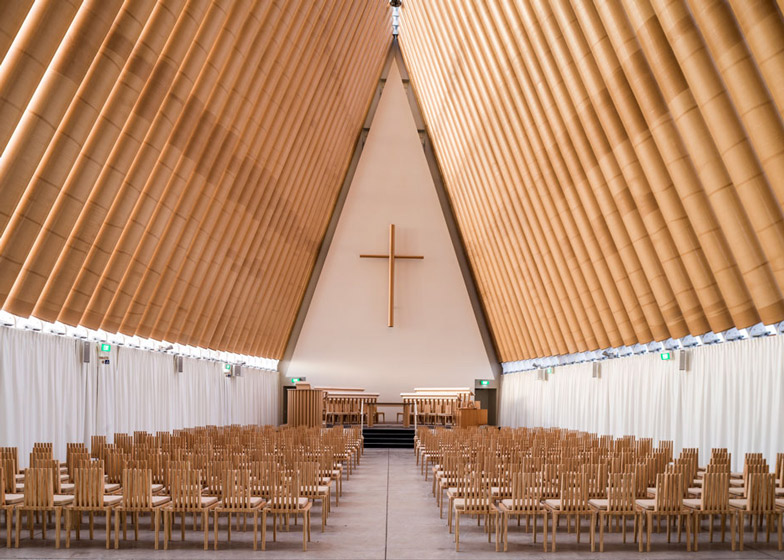I note that Japanese architect Shigeru Ban is this year's Pritzker winner. In a blog post in June last year, I reflected at length on Ban's energetic promotion of his signature paper prototypes in the inexhaustible 'emergency shelter' domain. It wasn't a kind reflection, asking whether the work had true value, or whether it was a notably focused polemic of self-promotion.
I am curious what will be said of his work in the flurry of commentary now he has Architecture's equivalent of the Nobel Prize. I think it is safe to say that Ban has succeeded in maintaining a rhetorical focus, until he stood out from his peers, and has now been duly rewarded.
However, one has to admit, that especially lately, Ban's buildings have taken on transcendental qualities that may have derived from a mastery of an unusual material, but also appeal more broadly to refined aesthetic sensibilities.
See a slide show of his work at Dezeen at http://www.dezeen.com/2014/03/25/key-projects-by-shigeru-ban/
I am curious what will be said of his work in the flurry of commentary now he has Architecture's equivalent of the Nobel Prize. I think it is safe to say that Ban has succeeded in maintaining a rhetorical focus, until he stood out from his peers, and has now been duly rewarded.
However, one has to admit, that especially lately, Ban's buildings have taken on transcendental qualities that may have derived from a mastery of an unusual material, but also appeal more broadly to refined aesthetic sensibilities.
See a slide show of his work at Dezeen at http://www.dezeen.com/2014/03/25/key-projects-by-shigeru-ban/

2 comments:
My congratulations go to Shigeru Ban.
Prompted by this post to look back at your previous post on emergency shelter competitions, and Neustein's article [http://www.australiandesignreview.com/opinion/2038-a-paper-thin-humanitarian-ethos], I hope to take the opportunity to respond here in some defence of Ban and the competitions.
The concerns for purely pragmatic design in the increasingly present disaster relief efforts are well deserved. Paraphrasing your earlier post, "50 [houses] for Haiti's 1,200,000 homeless" may be entirely fruitless in itself.
With that said, although his approach may lack the modesty, rigor and downplayed nature of other architects such as Pholeros of Healthabitat, Ban has shown in almost 20 years of practice that he has real concerns for these emergency disaster responses (http://www.dezeen.com/2014/03/24/shigeru-ban-wins-pritzker-prize-2014/). It would be remiss to argue that he spent that much of his life as a shamefully disguised act of self promotion. Furthermore, one could consider the span of his influence to be greater still, having operated on responses to disasters and in sustainable /renewable materials for longer than any of the NGO's listed have existed (Architects sans Frontières, Architecture for Humanity, Elemental, Emergency Architects and Healthabitat).
Just as Al Gore earned himself a Nobel Peace Prize in 2007 for his efforts to "build up and disseminate greater knowledge about man-mage climate change" (http://blog.algore.com/2007/10/i_am_deeply_honored.html), Ban's work will undoubtedly continue to influence aspiring architects to recognise the significance of architecture in disaster response efforts. The Pritzker prize may provide him a wider platform to express these modes of thinking.
Ultimately it is not in comparing the efforts of Ban and Pholeros that disaster relief architecture may progress. Rather, it is in the broadened recognition of the significance of architecture as a platform for aid in which we should commend both as well as appreciate the competition projects that universities across the world have pursued.
¬ The project in the image above feels very close to home as I grew up in Christchurch and experienced the earthquakes first hand. This project is Shigeru Ban’s Cardboard Cathedral in Christchurch New Zealand. I have personally visited Ban’s Cardboard Cathedral and I have mixed opinions about it. The new cathedral is symbolic towards Christchurch’s rebuild in the years to precede the earthquake and a place for reflection on the events of February 22nd 2011. It has given hope to many people for the future. On the other hand I am not truly convinced a new cathedral is what was really needed in Christchurch with 10,000+ homes being demolished and thousands of people either left homeless or living in unstable structures.
During my visit to this building I learned that this building costs over $1000 a day to run. It is surprising that this money is being spent on a tourist attraction while so many people are still left without a stable home following the 3-year anniversary of the earthquake.
The argument here is whether this building provides enough value for the cost, the cost of the building being $5.3 million (http://www.stuff.co.nz/national/9865626/Cardboard-cathedral-designer-wins-top-prize). This goes back to Steve King’s thoughts above and in ‘Emergency shelter: a higher purpose?’ (http://stevekingonsustainability.blogspot.com.au/2013/06/emergency-shelter-higher-purpose.html), as to whether these architectural innovations are merely for Ban’s self-promotion. I believe Ban was trying to help this situation as he designed the Cathedral free of charge; he was able to help New Zealand while Japan, his home country, was in need too.
However, one thing I can’t get my head around is how this is said to be a sustainable building but also a temporary structure. These two statements contradict one another.
This building symbolizes hope and new life while also being a significant reminder of what happened as it is in view of the CTV site where 115 people were killed. I don’t believe the ‘emergency structure’ idea was achieved with the Cardboard Cathedral. An “emergency structure’ by nature is built quickly for an intended short term use, however it took more than 2 years to build and the building is now said to have a significant lifespan (http://www.architectural-review.com/buildings/cardboard-cathedral-by-shigeru-ban-in-christchurch-new-zealand/8654513.article). This building has now been built to outlast another disaster like the earthquake, as said by Shigeru Ban himself ‘concrete buildings are damaged very easily but paper buildings cannot be damaged in an earthquake’ (http://architecturenow.co.nz/articles/christchurch-transitional-cardboard-cathedral/).
It is fair to say that Shigeru Ban’s ideas of an emergency structure where ‘good on paper’ but these ideas aren’t a reality post construction.
Post a Comment